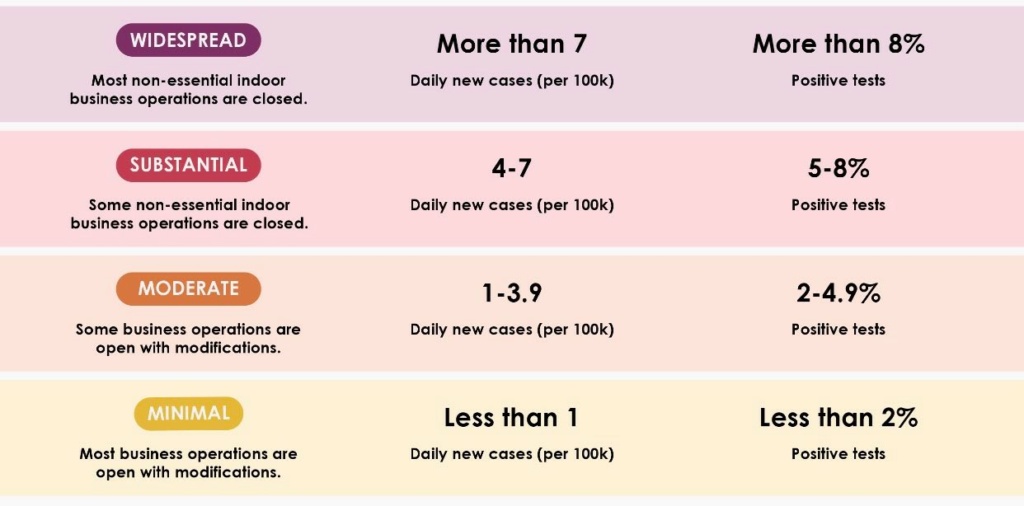California Issues New Reopening Guidance
Published: September 3, 2020
On August 28, 2020, California introduced the Blueprint for a Safer Economy, also known as “California’s Plan for Reducing COVID-19 and Adjusting Permitted Sector Activities to Keep Californians Healthy and Safe.” This new Blueprint was devised to aid California residents as the state reopens in the wake of the COVID-19 pandemic. Under this new plan, every county in California is assigned one of four tiers, based on the county’s test positivity and adjusted case rate. A county’s tier will determine what industries are permitted to reopen and what modifications are required.
As defined by the Blueprint, each of California’s 58 counties was assigned to one of the following four tiers based upon the counties health metrics on August 28, 2020, with Tier 1 (Widespread) being the most restrictive:

(See https://covid19.ca.gov/safer-economy/)
While the California Department of Public Health (“CDPH”) will assess and release the health indicators each week, to move to a less restrictive tier, a county must have been in the current tier for a minimum of three weeks, and must meet criteria for the next tier for the prior two weeks, in order to progress to the next tier. Further, a county can only move forward one tier at a time, even if metrics qualify that county for a more advanced tier. Alternatively, if during the weekly assessment a county’s adjusted case rate and/or test positivity has been within a more restrictive tier for two consecutive weekly periods, the county must revert to the more restrictive tier.
Much of California remains in the “purple” most restrictive tier, which significantly limits what industry sectors are permitted to reopen. A list of each industry sector, and when it is permitted to be open with modifications, can be found here: https://www.cdph.ca.gov/Programs/CID/DCDC/CDPH%20Document%20Library/COVID-19/Dimmer-Framework-August_2020.pdf. As counties move through the tiers, more industry sectors will be permitted to reopen based upon their perceived risk. The criteria being considered by the State to determine low/medium/high risk sectors includes the following:
- Ability to wear face covers at all times (e.g. eating and drinking would require removal of face covering)
- Ability to physically distance between individuals from different households
- Ability to limit the number of people per square foot
- Ability to limit duration of exposure
- Ability to limit amount of mixing of people from differing households and communities
- Ability to limit amount of physical interactions of visitors/patrons
- Ability to optimize ventilation (e.g. indoor vs outdoor, air exchange and filtration)
- Ability to limit activities that are known to cause increased spread (e.g. singing, shouting, heavy breathing; loud environs will cause people to raise voice)
The new public health order can be found here: https://www.cdph.ca.gov/Programs/CID/DCDC/CDPH%20Document%20Library/COVID-19/8-28-20_Order-Plan-Reducing-COVID19-Adjusting-Permitted-Sectors-Signed.pdf, and residents can refer to the Blueprint for a Safer Economy website here: https://www.cdph.ca.gov/Programs/CID/DCDC/Pages/COVID-19/COVID19CountyMonitoringOverview.aspx.
As always, the Labor and Employment attorneys at Weintraub Tobin continue to wish you and yours health and safety during these challenging times. If we can assist you with your employment law needs, please feel free to reach out to any one of us.

